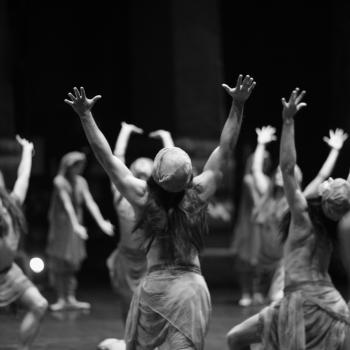Connor Wood
Pretend you’re an alien anthropologist come to Earth to study humans. What do you notice most about these strange, bipedal creatures? Their glittering cities? Their fondness for chocolate? Their use of daringly creative insults during traffic jams? Maybe, but let’s not forget one behavior that distinguishes humans almost more than anything else: ritual, and lots of it. No other animal participates in, invents, or performs rituals as complex and detailed as humans. But why? Our bemused alien anthropologist might benefit from new Danish research describing how ritual, using what’s called “cognitive resource depletion,” helps cultures pass knowledge and values down to new members.
Writing in Religion, Brain & Behavior, Uffe Schjødt and a group of colleagues at Aarhus University in Denmark (and one, Joseph Bulbulia, from New Zealand’s Victoria University of Wellington) used recent empirical findings to test a long-held hypothesis: that religious ritual helps cultures transmit knowledge – ethical norms, beliefs about the nature of reality, and so forth. This idea has a long and venerable history; a hundred years ago the sociologist Emile Durkheim argued that group rituals generate a “collective effervescence” that makes participants uniquely open to accepting the values, stories, and beliefs of their society.
Since then, many other scholars have generally agreed with Durkheim, but nobody really knows why ritual works this way. After all, lots of the elements of religious rituals would seem to make people less prepared to learn new information; how well can you be expected to pay attention when you’re also focused on getting just the right bodily postures correct, or when you’re lost in ritual ecstasy?
Well, if Schjødt and his colleagues are right, the answer is that you don’t need to be paying attention at all. In fact, for this kind of cultural transmission to be successful, paying attention is precisely what you want to avoid. Instead, the researchers claim, three seemingly counterintuitive aspects of ritual actually suppress conscious cognition: the regulation of emotion; actions that lack obvious purposes or goals; and the presence of a charismatic authority. By bypassing direct cognition, these features of ritual allow cultural learning to pass from religious experts to ritual participants unimpeded.
Cognitive Resource Depletion
The researchers’ model depends on a process known as “cognitive resource depletion.” The brain is (as we all know) extremely complex, but evolution has also forced it to be very efficient. This means that many cognitive functions run on the same neural hardware. For example, executive cognitive functions – which give rise to focused, goal-oriented behavior, integrating many smaller process and tasks into overarching wholes – largely depend on the same regions of the frontal cortex that power attentional processes. So the more you’re focusing your attention on something specific, like a counting clock, the poorer you’ll perform on tasks that demand executive function.
Emotional regulation, as it happens, is just such an attentional process. Schjødt and his colleagues suggest that controlling emotional expression during religious rituals actually uses up cognitive resources that participants would otherwise use to develop a robust model of what’s happened during the ritual. The researchers describe this model-building as “updating.” Our brains make sense of perception and experience by constantly testing internal models against incoming data; whenever there’s a discrepancy between what the brain thinks it’s going to encounter and what it actually encounters, it compensates by “updating” its internal model. But if you’re overloading your frontal lobes, your brain can’t perform its normal updating function. The result is that you won’t be entirely clear on what’s happened to you, so you’ll need to rely on your prior expectations, your cultural values, and what others tell you in order to make sense of your experience.
Supporting this hypothesis, Schjødt and the other researchers found that Spanish firewalkers had poor recollections of their experiences immediately after completing a firewalking ritual – during which they were expected to be stoic and not express pain or fear. Several months later, however, the firewalkers confidently reported much more detailed memories of the ritual. However, the “new” memories weren’t objectively accurate – many of the newly recalled details matched local religious and cultural expectations of what a firewalking experience was supposed to be, but video recordings showed that they didn’t match what had physically happened during the ritual. The sheer cognitive demand of the firewalking ritual left the participants open to suggestion and guidance from the ambient culture and the religious authorities who led the ritual. Their interpretations and memories of the experience were “filled in” by these external sources.
Similar relationships were discovered when the researchers focused on the non-goal-oriented nature of ritual and on charismatic authority. In one study, participants were asked to describe videos showing both goal-oriented and seemingly purposeless activities. The participants broke down the purposeless activities into more discrete steps – suggesting that their brains were expending energy trying to make sense of what they’d seen. Since nearly all rituals feature activities and behaviors that aren’t aimed at trying to accomplish anything practical, the authors claim, it’s likely that our brains are doing something similar during these seemingly “purposeless” rituals – breaking them down into many small steps, trying but failing to analyze them for an underlying sense. This process also draws heavily on cognitive resources, preventing participants from generating their own interpretations of the ritual experience.
Which leads, finally, to the role of the charismatic authority. According to Schjødt and his fellow co-authors, charismatic religious leaders – priests, shamans, and the like – are able to step into ritual participants’ resource-drained neurology, telling their own stories about what’s happened during the ritual and what its meaning and purpose is. In a very real sense, the massive cognitive deficits people experience during demanding rituals place them in a perfect position to be influenced afterwards by external interpretations flowing from religious authorities. In this way, everyone who participates in a ritual becomes ever-so-slightly enculturated into the ambient religious worldview afterwards.
Schjødt and his colleagues leave several questions open, of course. For starters, not all rituals clearly require emotional regulation; ecstatic religious rituals such as a Pentecostal Sunday service or a Voodu fète demand almost anything but the suppression of emotions. More importantly, many religious people would likely balk at the claim that their cherished rituals are “purposeless” or, as the authors put it, “characterized by incomprehensible actions.” Take the Eucharist: to an outsider, it may seem odd to dip a dry bit of bread into wine and eat it, but to the participant the goal is obvious: to participate in the divine body of Christ. Similarly, the prostrations of a Muslim congregation at prayer might not seem “purposeful” to an outsider, but the faithful will quickly tell you that the purpose is obviously to fulfill salat, one of the five pillars of Islam, and to praise Allah.
The definition of “purpose” is always contextual, but Schjødt and his colleagues, following many contemporary biologists and philosophers, assume that purpose only counts if it’s directly associable with the bare Darwinian goals of survival and reproduction. But despite some questionable philosophical assumptions, their findings shed some much-needed light on the mechanisms by which religious rituals shape and drive societies. It’s been known for decades that religious rituals prime participants to accept and be shaped by the beliefs of their religious cultures. Now we may have some real insight into how this works. Schjødt and his colleagues would say that the reason why a Muslim knows the “purpose” of prayer is because cultural authorities have told her what it is after her own cognitive hardware has been depleted by ritual. The believer herself would say it’s because she has faith in Allah. Knowing the actual neurological and cultural pathways through which ritual works may help us mediate – if not actually reconcile – these two competing visions.













